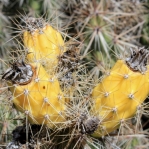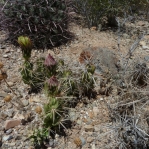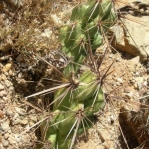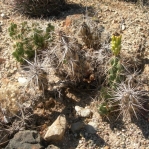Engelmann. 1856. Proceedings of the American Academy of Arts and Sciences 3: 304.
Herbarium specimen; Herbarium specimen; Herbarium specimen; Herbarium specimen; Herbarium specimen; Herbarium specimen; Herbarium specimen; Herbarium specimen; Herbarium specimen; Herbarium specimen
Original species description
Club Chollas of the Big Bend 3.0
The Flora of North America treatment
What is Corynopuntia emoryi?
Corynopuntia emoryi is a dog cholla of the Big Bend region that form clumps or mats of stems to 10-30 cm high and up to 150 cm across.
Details
C. emoryi cladodes are curved-clavate, gradually to abruptly narrowed at base, 7-19 × 2.5-5 cm, and the tubercles are very prominent (20-50 mm and 1-3.5 times longer than wide) not or little obscured by spines. The areoles are 4-6 mm in diameter with white to gray wool. There are 12-30 spines per areole, mostly in apical areoles to ± uniformly distributed along stems. The spines are spreading, yellow, tan, or red-brown, tipped yellow to 3-7 cm. The major 3-5 abaxial spines are divergent, yellowish or red-brown, angular-flattened, sharp-edged, whereas the major (1-)3-5 adaxial spines are ascending-divergent, tan or red-brown, angular-flattened to subterete. The most recent treatment is in Club Chollas of the Big Bend 3.0 (see Appendix E). C. emoryi has diffuse, hair-like roots and is tetraploid.




